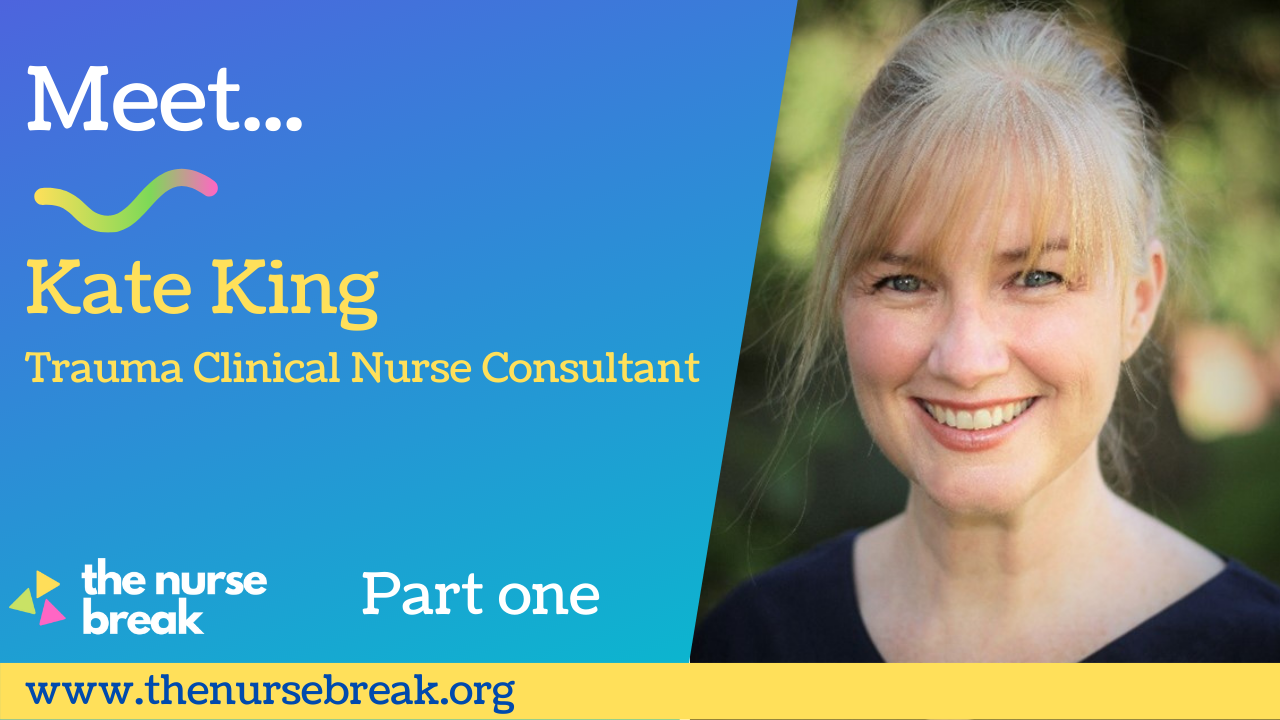Table of Contents
Meet Kate King! A nurse with 27 years of experience, primarily in trauma, Kate has worked within Australia and internationally. Kate’s current role is in Trauma as a Clinical Nurse Consultant III (CNC), in a mixed adult and paediatric major trauma centre in Newcastle. She balances her busy role with parenting teenagers and two Cavoodles, and a keen interest in true crime podcasts. Kate gives us insight into the role of the Trauma CNC and trauma nursing as a speciality.
Check out our related content here:




What have you loved about 27 years of nursing and your role as a Trauma CNC?
It sounds cheesy, but honestly the thing I love the most about trauma nursing are the patients. Even after all these years I cannot believe what a privilege it is that our patients, their family, and their friends put their complete trust in us to take care of them.
They surrender all control to people they have never met at a time when they are most vulnerable and literally put their lives in our hands- I just find that an amazing trait in humans.
kate king
There are lots of other things I like about Trauma nursing; no two days are the same; just when I think I have seen it all a new mechanism of injury or new injury comes in; and I would love to write a book on all the bad and mad tattoos I have seen. I love seeing our patients return long after their injuries because they feel connected to us. I love the team I work with as it is truly multidisciplinary and I think produces great outcomes, I work with an awesome group of nurses who I wouldn’t be able to survive without and a great team of surgeons and allied health.
How do you define trauma?
There are lots of different definitions for trauma, physical and mental, minor to catastrophic, but my role as a Trauma CNC is well defined. The trauma system in Australia is well developed and NSW has quite a mature trauma system. Trauma CNC’s work in Major Trauma Centres (like me) or in Regional Trauma Centres. For us, a trauma patient is someone who has been physically injured (although there is always a psychosocial impact) who requires specialist input in all aspects of their care from pre-hospital, through to Trauma Team Activations and admissions under the Trauma Service, and maybe transfer to or from another trauma centre or through to rehabilitation.
We tend to deal with high energy trauma like road trauma, high falls, interpersonal violence, stabbings, shootings etc., and generally patients have more than one body system injured, for example they may have a traumatic brain injury, rib fractures, a splenic laceration, and fractured lower limbs. However, we do look after patients with significant life-changing single system injuries such as acute spinal cord injuries and burns.
In trauma terms, there are very specific definitions of injury extent- commonly used is the ISS: Injury Severity Score (from the AIS: Abbreviated Injury Scale; a dictionary that gives every possible injury its own unique score). An ISS score >15 is considered severe. Trauma is still the number one cause of death in 0-44 age bracket worldwide and contributes to significant morbidity in those who survive, so it is an important area to focus on in health, from prevention right through to rehabilitation.
There are lots of subspecialty nursing areas that deal with trauma patients, including ED nurses, OT, anaesthetics/recovery nurses, ICU nurses, ward nurses, outpatient nurses and rehab nurses- this provides numerous opportunities for exposure to trauma nursing.
What does a day in the life of a Trauma Clinical Nurse Consultant look like?
Every day is completely different; the only predictable thing is how unpredictable it is. Even though I am a control freak, I find unpredictability keeps things interesting. We tend to work morning shifts because it aligns best with medical rounds and early referrals to allied health. My role is Monday to Friday, although we have seven day a week cover for case management. I see all the new admissions that have come in overnight and make sure the right teams are involved, referrals have been made, tertiary surveys are completed (ie. looking for missed injuries).
I work with a team of doctors, other CNCs, and case managers. I attend any Trauma Team Activations that occur whilst I am in the hospital- this may take thirty minutes, or for more complex cases I can be in ED for hours. The Trauma CNC acts as the scribe and nurse team leader in the resuscitation room at our institution. We are an adult and paediatric major trauma centre, seeing a high volume of high acuity patients.
As a CNC 3, I have commitments at national, state and district levels, which includes writing policy, attending accountability meetings, presenting at conferences and being the Trauma nurse representative on state and national committees. I always have a lot of paperwork to do and meetings to attend.
Currently I am writing book chapter and updating another and have two journal articles on the go- this is my least favourite part of the job and I procrastinate a lot. I am heavily involved in quality assurance projects like weekly trauma audits, reviewing all trauma related deaths at both a local and state level, and I find this aspect of the job both interesting and rewarding.
I am also heavily involved in our departments research program which ranges from registry-based studies right through to being the research coordinator for international multicentre clinical trials. I also provide education to nursing and medical staff in hospital, I teach in both undergraduate and post graduate courses for the College of Health, Medicine and Wellbeing at the university.
The Clinical Nurse Consultant role includes domains of clinical service and consultancy, clinical leadership, research, education, and clinical services planning and management, and my job covers it all.
kate king
I have endless lists of jobs that need ticking off and I never have a boring day, I work with an awesome team of nurses and doctors who are all really passionate about trauma and I am very fortunate to have amazing support staff to help me with a lot of the grunt work that no one sees.
What are the most common causes of traumatic death you see?
There are many articles about the trimodal distribution of death from trauma in the 1980’s where they described a group of trauma patients that died at the scene; a group that died within the first 24 hours (usually from uncontrolled haemorrhage); and a group that died weeks or months after their injury from organ failure.
As road safety and pre-hospital care have improved, we have seen a big drop in the first group and now there is really a bimodal distribution of death, where patients die from un-survivable injuries, or die weeks after injury. It is rare in Australia for patients to make it to the Major Trauma Centre and die within the first day and even rarer to die from a preventable death (meaning we could have done something to aid their survival).
Once in hospital, Traumatic Brain Injury (TBI) is still our number one killer in trauma. I have been fortunate enough to be involved in the Federal Governments expert advisory panel for Medical Research Future Fund (MRFF) which granted 10 million dollars towards TBI research, and TBI Connectivity which is a not-for-profit organisation comprising of researchers, scientists, clinicians, and people living with TBI. This is an incredibly exciting time because it has bought people together Australia-wide from different backgrounds with the shared vision of improving outcomes for patients and families who have experienced TBI.
We still see the occasional patient who dies from uncontrolled haemorrhage; these patients would have traditionally died at the scene but because we can transport very sick patients in a short period of time they die in ED or OT instead, from what are basically un-survivable injuries. Following TBI, the next bigger killer in hospital is post injury multiple organ failure and this happens in the weeks after the injury.
A bit about post injury multiple organ failure
Post injury multiple organ failure (MOF) is the major cause of late morbidity in trauma patients. This is really the result of improved health care- traditionally these patients would not have survived their injuries long enough to develop organ failure, it tends to occur in the severely injured and is often fatal. This is an area that our institution does a lot of research into as even though we know it is occurring we haven’t quite unlocked why some people get it, and others don’t; why some people die from it, and others recover.
If we could predict it better and gain a better understanding of the complex inflammatory response that the body goes into following a massive insult such as trauma, we may be able to make an impact in the high morbidity and mortality associated with MOF by modifying our treatments. It is a reasonably nerdy topic but of great interest to us. This article provides a great overview of MOF. ABC Catalyst also had an episode where our Director of Trauma spoke on the topic of multiple organ failure.
Some examples of major trauma you have seen
I am always amazed at paediatrics that come into ED peri-arrest after being run over by a reversing car or something similar and have big intra-abdominal injuries or even head injuries and then skip out of hospital happy as Larry two weeks later as if nothing has happened (usually being held by a very tired and emotional parent).
Really big traumas where every body system is injured and the patient is incredibly unstable, usually from high-speed motor vehicle accidents (MVAs) where you immediately have a team of 10-15 experts in their fields working to stabilise the patient: working together like a pit crew for a formula 1 racing car. In, out, stabilised. These are rewarding as a team member, because, regardless of the outcome, you know everyone has given their all. However, when patients who should have died, not only survive but prosper it makes everything more rewarding.
I have seen a lot of foreign bodies where they shouldn’t be, wooden stakes through chests, drill bits through testicles, tree trunks in groins, and steak knives in hearts, hands, and kidneys.
kate king
The most interesting cases are the mixed mechanisms so blunt and penetrating, e.g., car accident and impaled by tree or fence because there are two different management strategies involved.
I have seen two people in the same accident with the same injuries that have had completely different outcomes, because everyone’s bodies react differently to trauma, and there is so much about our physiological response to trauma we still don’t know.
What are some unique pieces of equipment that are used in trauma?
Pelvic Binder
There have been a lot of equipment changes in Trauma over the years. The one that I think has had the most impact on our patients is the pelvic binder. Traditionally, patients that had open book pelvic fractures would have a mortality rate of up to 60% and that is now down to less than 10%. The reasons for such improvement are multifactorial; improved haemostatic resuscitation; early interventional radiology; improved pre hospital care; and most simply and importantly, the use of the pelvic binder. You can use a bed sheet and four clamps, or there are lots of commercial options. The one that is used most commonly in Australia is the TPod.

Massive Transfusion Protocols
One of the other great advances in Trauma care is not a piece of equipment, but the introductions and refinements of the massive transfusion protocols (MTP). Our hospital was an early adopter and it really made the process of getting large volumes of blood and blood products easier, timely, and safer.
When I started in trauma everyone got 2 L of crystalloids just for turning up and seeing a heamodynamically unstable patient getting 10 or 12L of crystalloid was not uncommon. We learnt the hard way that this was bad for trauma patients so giving them blood with clotting factors early really decreased the number of patients who were deep in the triad of death being hypothermic, coagulopathic and acidotic, and therefore improved outcomes.

The helicopter
One of the other revolutionary pieces of equipment in Trauma care is the helicopter. Granted it’s an incredibly expensive piece of equipment and inherently dangerous, but it can really mean the difference between life and death in a big trauma for three reasons.
- it can take the critical care team to the patient instead of having to wait for ED
- the team can provide lifesaving treatment such as giving blood and inserting chest tubes
- it can transport the patient long distances in short periods of time.
All of these give the critically injured patient a better chance of surviving to hospital.

VAC dressings
I think one of the other great advances in trauma care and to nursing, in general, is the introduction of vacuum-assisted closure (VAC) dressings. It has been revolutionary to wound care in trauma patients especially when they are really bloated from big volume resuscitations and not able to have their wounds closed in the first instance.
What are some misconceptions about trauma nursing?
People think it is sexy and exciting and all about the resuscitation. Certainly, it is exciting in the Emergency Department and it’s the only field that pools such amazing human resources in a very short period, but that is just a minute part of the trauma journey: often there is 15 minutes spent in ED and weeks and months in ICU and on the trauma wards that are anything but exciting or sexy. That is probably the main misconception. Trauma nursing is a small and specialised field that is relatively new in Australia, so is often misunderstood, but it’s an incredibly rewarding field to get into.






You must be logged in to post a comment.